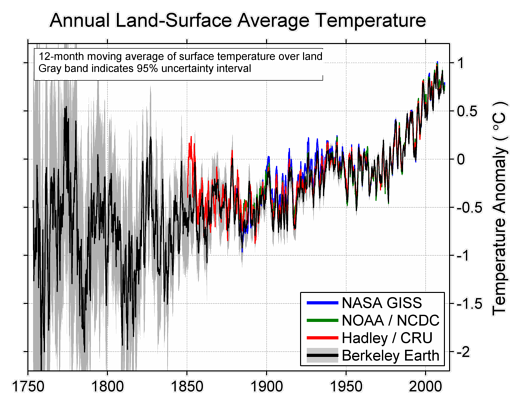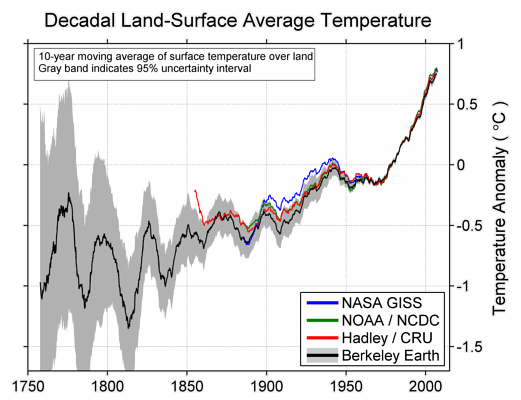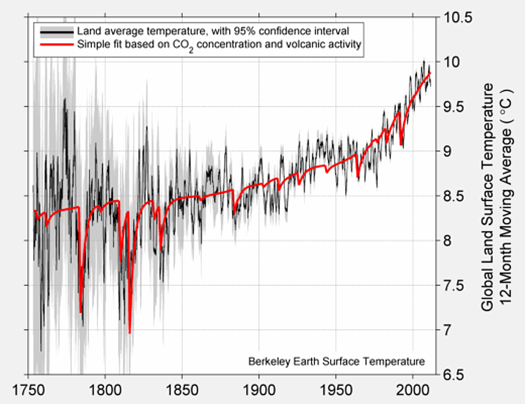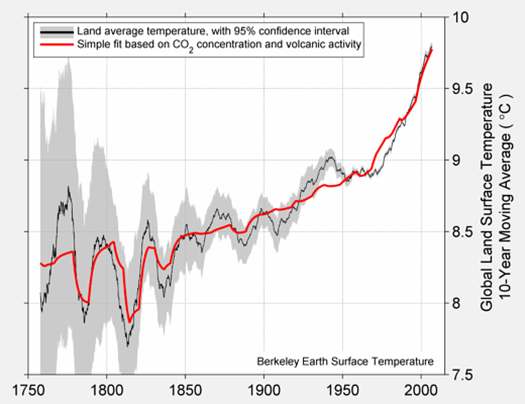Our ongoing research includes the study of climate variability, extreme events, and the role of the oceans. View a three page summary of our initial project objectives and early results. A two page summary of our results to date, aimed primarily at the media, is available by clicking here. More technical results, meant primarily for scientists, are presented below.
Global land temperatures have increased by 1.5 degrees C over the past 250 years
Berkeley Earth has just released analysis of land-surface temperature records going back 250 years, about 100 years further than previous studies. The analysis shows that the rise in average world land temperature globe is approximately 1.5 degrees C in the past 250 years, and about 0.9 degrees in the past 50 years.


Land temperature with 1- and 10-year running averages. The shaded regions are the one- and two-standard deviation uncertainties calculated including both statistical and spatial sampling errors. Prior land results from the other groups are also plotted. The NASA GISS record had a land mask applied; the HadCRU curve is the simple land average, not the hemispheric-weighted one.
Land temperature with 1- and 10-year running averages. The shaded regions are the one- and two-standard deviation uncertainties calculated including both statistical and spatial sampling errors. Prior land results from the other groups are also plotted. The NASA GISS record had a land mask applied; the HadCRU curve is the simple land average, not the hemispheric-weighted one.
Berkeley Earth also has carefully studied issues raised by skeptics, such as possible biases from urban heating, data selection, poor station quality, and data adjustment. We have demonstrated that these do not unduly bias the results.
Human Effect
Many of the changes in land-surface temperature can be explained by a combination of volcanoes and a proxy for human greenhouse gas emissions. Solar variation does not seem to impact the temperature trend.


The annual and decadal land surface temperature from the BerkeleyEarth average, compared to a linear combination of volcanic sulfate emissions and the natural logarithm of CO2. It is observed that the large negative excursions in the early temperature records are likely to be explained by exceptional volcanic activity at this time. Similarly, the upward trend is likely to be an indication of anthropogenic changes. The grey area is the 95% confidence interval.
Click here to see the historic temperature record with named volcanos.
After accounting for volcanic and human effects, the residual variability in land-surface temperature is observed to closely mirror (and for slower changes slightly lead) variations in the Gulf Stream.
Video
Berkeley Earth video representation of the land surface temperature anomaly, 1800 to the present.
Learn more
Berkeley Earth has published five scientific papers setting out the main conclusions of the study to date:
- A New Estimate of the Average Earth Surface Land Temperature Spanning 1753 to 2011
- Berkeley Earth Temperature Averaging Process (commonly referred to as the “Methods” paper) and its appendix
- Influence of Urban Heating on the Global Temperature Land Average
- Earth Atmospheric Land Surface Temperature and Station Quality in the United States
- Decadal Variations in the Global Atmospheric Land Temperatures
The Berkeley Earth team is making these preliminary results public, together with the analysis programs and data set in order to invite additional scrutiny as part of the peer review process.
You can also look up the temperature record by location (city, country, etc.).

